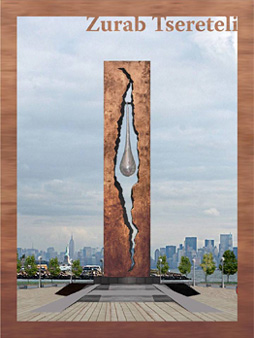
The artist, Zurab Tsereteli, was in his home in Moscow on the morning of September
11th. The television was on as he was getting ready for work and Zurab, like the rest
of the world, was glued to coverage of the attacks on the Twin Towers. He watched
the towers collapse on TV and was moved to tears. That day, he went to work at the Academy of Art driving on a route that takes him
past the American Embassy. People were gathered outside the embassy gates to pay
sympathies, to be together, and to mourn. He saw a mass of crying people and
decided to use the image of a tear in a memorial.
He set to work that day on a proper and appropriate form through which to express
his feelings over the attack. He went through many various sketches and ‘forms’ (all
of which are chronicled in the yellow book) until finally deciding on the current
monument’s form.
Zurab traveled to NY shortly after the September 11th and went to ground zero. The
ruins were still steaming. He decided that he wanted to create a memorial to the
victims; but that wouldn’t want to build on top of the bones of the dead on the ground
zero site. He began to look for an appropriate and fitting site on which to erect the
memorial.
Zurab spoke with friends and colleagues who were in NY during the attacks. He
heard stories about how boats and ferries were used to shuttle survivors away from
the Twin Towers. He also learned about the New Jersey residents who worked in the
towers. Zurab decided to look for a site in New Jersey, where the monument could
be on the waterfront and settled on a never before seen area of the peninsula at
Bayonne. Here, the World Trade Center was the backdrop to the waterfront, and so,
the backdrop of life. The site had been a military instillation, and the town had
decided to convert the land into public park-space.
From this vantage point, the Twin Towers looked almost as if they were in fact one
building. His bronze monument reflects that image with a jagged tear through the
center, and a 4-ton nickel tear hanging from the top. The tear represents not only the
sadness and grief over the loss of life on 9/11 and previous attacks on the World
Trade Center, but also hope for a future free from terror.
The monument has several reflective elements, so that the visitor becomes part of the
memorial. The nickel tear is shiny and mirror like. The granite name plates which
make up the stand for the monument, and on which the names of the victims are
etched, is also shiny and reflective.
To the Struggle Against World Terrorism - A History